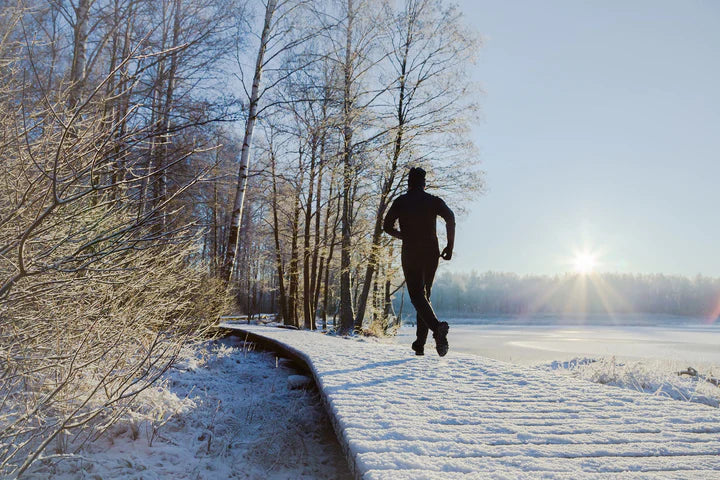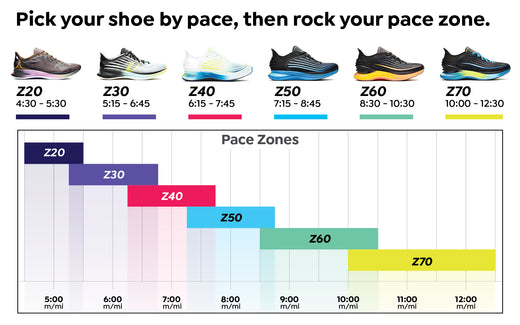The Trampoline Effect & Energy Return
Many of us have heard the term “trampoline” used by people to describe the feeling of certain running shoes. But what does that actually mean in terms of the energy you expend while running?
I've found that describing how real trampolines work provides important insights into how the human body works. Then, by distinguishing between a trampoline and a human we can understand what happens in a so-called super-shoe.
If you’ve ever jumped on a trampoline, this will sound intuitive. A trampoline works as a giant spring (giant compared to a human trampolinist) where the steel spring coils arrayed on the perimeter have a certain stiffness and the canvas stretching between them can bend without stretching. When a massive object, like a trampolinist, falls under the force of gravity onto the trampoline, the kinetic energy of the body stretches the spring coils from their state of equilibrium. The trampolinist experiences the sensation of sinking into the trampoline and then being propelled back up into the air. Let’s describe this in slightly more detail.
The motion of a trampolinist in contact with the trampoline can be described, to a very good approximation, using Hooke’s Law
𝐹 = 𝑘𝑥
F = force
k =
the strength of all of the springs added together which is constant
x = the distance the trampolinist sinks below the flat surface of the trampoline (this measured from the centre of gravity which is in the middle of your stomach)
The spring constant describes the overall stiffness of the trampoline. Note that there are two separate pieces to bouncing on a trampoline: the piece when you are touching the canvas and the piece when you are in the air. Hooke’s Law only applies to the piece in contact with the canvas. This is important, because the length of time a trampolinist is in the air is different from the time touching the canvas. We know this intuitively either from watching a gymnast or bouncing on a trampoline ourselves. But the distinction is important.
A trampoline, like other springs that obey Hooke’s Law, has a natural frequency of oscillation that depends on the mass of the trampolinist and the trampoline’s spring constant k. We can look at the math equation for the natural frequency, but the important thing is to get an intuitive feel for what a natural frequency is.
Here is the equation that describes the natural frequency:

W (omega) = the rate at which the canvass bends (angular frequency)
K = the strength of all of the springs added together which is constant
M = the mass of the trampolinist
Think of angular frequency as the rate of oscillation or how quickly it goes down and up. In words, this expression says that when the spring stiffness is higher (k is bigger), the frequency is faster because the canvas does not sink as much and therefore there is a shorter time to return to the flat position. And when the mass is greater, the frequency is slower. This should make intuitive sense too, because a heavier mass will stretch the trampoline farther, so it will take longer for it to stretch and then bounce back. Conversely, a stiffer spring won’t stretch as much, so it will take less time to stretch and recoil.
The most significant takeaway from the above discussion of Hooke’s Law is that the natural frequency depends only on the mass and spring constant. It doesn’t matter how high the trampolinist jumps or how much force they land with: The time it takes to stretch and rebound will be the same regardless of jumping height. This turns out to be a very useful thing for the trampolinist, because it allows them to time the flexing of their legs in sync with the trampoline. After jumping for a few repetitions on the trampoline, we figure out how long it takes (i.e. we mentally keep track of the natural frequency) so we can bend our knees when sinking down and extend them when the trampoline is pushing us up. This is called being in resonance with the trampoline (like being in time with the beat of a song) and it is what allows us to jump higher and higher.
The most important thing to remember about resonance is that it is our bodies that must match the natural frequency of the trampoline to get the energy return that propels us higher. We have to consciously do this and it takes some practice. The trampoline does not adjust its frequency to match ours. If we are not very good at timing our jumps with the trampoline, we push off at the wrong time and we don’t get effect of energy return. The same thing applies to diving boards and gymnastic springboards. This isn’t about how hard we push off, it’s about the timing of the pushoff, similar to hitting a baseball, kicking a football or hitting a golf ball, get the timing right and goes a lot further.
What does this have to do with running and running shoes? First, think about barefoot running. When we run, the time we are on the ground pushing off is determined by our bodies. It is a definitive function of our cadence and stride length (the math gets a little bit hairy). The important point, however, is that the contact time is set by our bodies.
Now imagine that we put springs under our feet and go running. The contact time is still set by our bodies. If we choose, we can run barefoot at a certain cadence and stride length, then strap springs to our feet and run with the same cadence and stride length.
What does this have to do with the natural frequency of the springs attached to our feet? Nothing. The two are unrelated, because the spring’s natural frequency is determined by the spring constant and body mass, and the ground contact time is determined by cadence and stride length. In the case of running shoes, the “springs” (i.e. the recoil from the shoe sole) are very short (relative to a trampoline!) and the natural frequency is likewise very short time your foot is in contact with the ground. Since the ground contact time and the spring frequency are not the same, the spring cannot return energy to the runner.
This can be proven mathematically, but the point of this post is to convey it conceptually.
When a runner says that their shoes feel like trampolines, they may be describing the sinking feeling, but aren’t describing the rebound (at least not in a physical reality sense). Since their shoes are not returning any energy, they can’t be helping the runner move with less energy.




